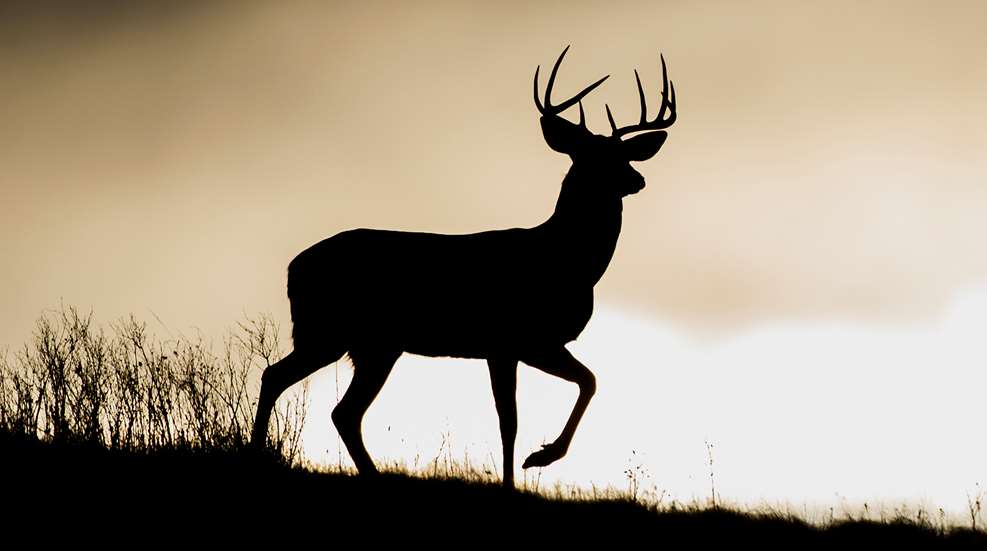
It’s a tale as old as hunting itself, but one that until December of 2021 I’d only heard around campfires and barstools from someone who “knew a guy.” But, as life has taught me many times over, these common tales become common for a reason.
Let’s get the embarrassing part out of the way: I screwed the pooch on this one. The buck was down. Dead where I shot him, or so I assumed. Sure, he flicked an ear in the beginning, kicked a bit, but they do that sometimes. My shot looked and felt good, and he’d been down a long time, an hour or more. Laying there 15 yards from the pile of Kansas gold he’d been sluicing through, he sure looked dead to me. But again, they do that sometimes. Like a soiled carney running the ring toss at the county fair, that big Kansas buck was playing me for a fool, and I obliged to make it no hard task.
Assuring Ted Jaycox, owner of Kansas-based Tall Tine Outfitters, that the buck was dead for the umpteenth time, we slowly closed the near 90-yard distance between the elevated box blind and the horizontal 10-point. At 20 yards, using a large bush to mask our final approach, rifle ready and power turned to 4X, I stepped out to the right of that bush for a clear line of sight. I never cleared the bush before the buck-colored blur exploded up and out, leaving nothing but dust, empty space, and a hunter looking to turn back time. Lucky for me, Ted was there to witness my folly. Unlucky for me, he’s got a helluva memory and a lot of campfires in his future.
Ted Jaycox has been putting clients on big Kansas whitetails for the past 20-plus years, and if there’s one guy I want by my side when things go south, Ted is that guy. Ted understands deer behavior better than anyone I’ve met. He’s old school in some ways, keeps things simple, but in the ways that elicit the utmost faith and trust in his ability. Spoiler alert: We found the buck the next morning, exactly where Ted said we would, a fevered zombie standing knee-deep in the river about a hundred yards from where he was first shot. One more shot and he was down, for good this time. It’s the biggest whitetail buck I’ve ever killed, and Ted’s knowledge of hunting big bucks is the only reason that rack is now on my wall.
With an aim to bring some of that knowledge to you, I recently phoned Ted to pick his brain with a little deer-season Q and A. Here are the useful highlights from our long conversation. I’ve no doubt we can all learn a little something to take to the woods.
■ ■ ■
On Guns, Ammo, Archery and Optics
Jon: Okay Ted, here’s some tough questions.
Ted: Shoot.
Jon: What is the best rifle cartridge for deer hunters?
Ted: (long pause)
Jon: If you had to choose one?
Ted: I’d shoot a Bowtech, set at about 70 pounds with a 125-grain Montec. I don’t know, what’s your favorite?
Jon: Well, okay, is there any caliber that you consider too small? Have you seen a bunch of deer lost with a .243 Win., or is the 6.5 Creedmoor not all it’s cracked up to be?
Ted: I can’t remember the last guy we had hunting with a .243, but you know, shot placement is everything. If you put it in the boiler room, it doesn’t matter what you shoot them with. We’re not shooting super long distances, so any good cartridge that you can shoot out to 300-400 yards is adequate. Some of these deer weigh 275-280 pounds, but I’ve had guys hunt with just about everything, and they all work.
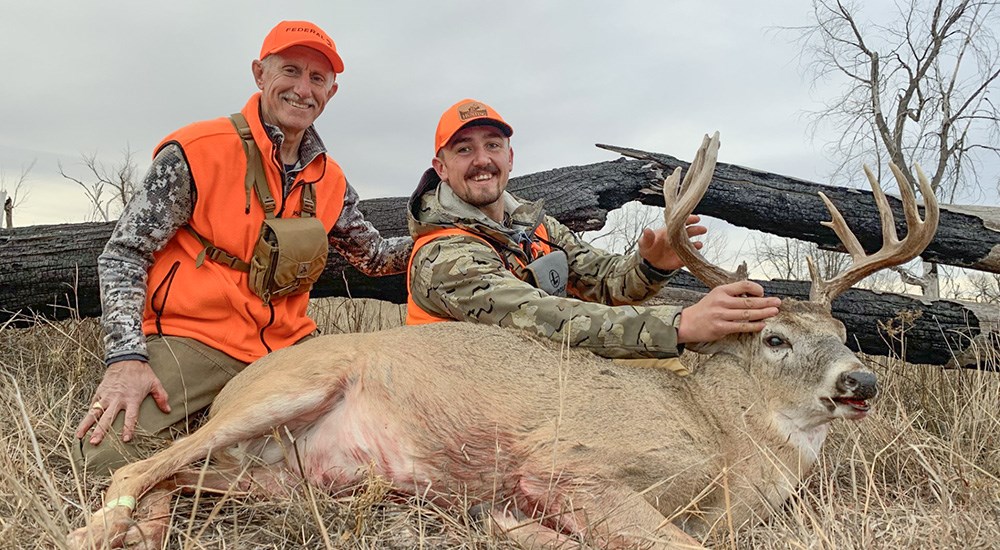 Ted Jaycox, left, is a bowhunter at heart, but he takes nearly as much pleasure in putting rifle hunters like Joe Ferronato, right, in front of mature Kansas bucks.
Ted Jaycox, left, is a bowhunter at heart, but he takes nearly as much pleasure in putting rifle hunters like Joe Ferronato, right, in front of mature Kansas bucks.
Jon: Any thoughts on bullets?
Ted: No, sorry. You know, our wound/loss ratio with rifle hunters is so small, that I haven’t paid enough attention to it, honestly. Not like I do with archery. With bowhunters I keep a tally in my head on what works and what doesn’t work. When a rifle hunter loses a deer, I’m not asking him “What bullet were you using?” I’m asking him where he hit it.
Jon: So, a good hunting bullet in the right place then, that’ll do the job?
Ted: Yup. That’s it.
Jon: Alright, let’s talk archery preferences. Do you have a poundage minimum?
Ted: You know, I don’t have a minimum. Most guys are shooting at least 55 pounds, and with the technology available today, you don’t have to shoot 70 pounds. Arrow flight and penetration is everything. I need a blood trail, so as an outfitter I want an exit hole. I’ll just say it: I get fewer exit holes with expandable broadheads than I do with fixed-blade broadheads. Although expandables have come a long way in the last few years, if I had my choice, I would have a good fixed-blade broadhead, like a Montec or a Muzzy, that can punch through and give me an exit hole for recovery.
Jon: I’m with you, Ted. I’ve blown up a broadhead on a ribcage before, and it’ll change your mind. Why risk it?
Ted: Man, I’ve shot through every elk I’ve shot with a bow because I’m using a heavy arrow with a lot of front-of-center weight, and a good fixed-blade broadhead. I don’t get the marginal penetration you often see with these light, super-fast arrows and expandable broadheads.
Jon: How about a max distance with archery? Is it as far as you’re comfortable shooting?
Ted: I’m not a fan of long distance, especially on whitetails, because they’re always moving and feeding. Anything over 50 yards I think is a bit far. But again, it’s what the hunter feels comfortable with. Ninety percent of our archery shots are under 20 yards with a bow. We try to make it easy. Easier, that is. It’s never easy.
Jon: Back to firearms, any thoughts on optics?
Ted: I don’t care if it’s a fixed 4-power, red-dot or whatever, if you can shoot it, shoot it. Well, actually, it needs to have low light capability, that’s critical. You need to be able to see at daylight and dark, because a lot of those bucks are moving then. But as far as magnification is concerned, we’re not shooting at 800 yards, heck, we’re not shooting 400 yards. Most of our shots are in that 150- to 300-yard range, so bring something you can dial down.
■ ■ ■
On the When and Where
Jon: If I want my best chances at a mature buck, when should I be hunting? Early season or late season?
Ted: I don’t offer it as an outfitter, but early season wins. And when I say early season, I mean the second Monday in September.
Jon: That’s specific.
Ted: Big bucks are still in bachelor groups and on feed patterns, entering fields late and early. The window of opportunity is short, but you can kill a monster in Kansas in early September. I used to offer it, until I decided I’d rather elk hunt than make money. As I’m getting older, I have more money than time it seems like. Outside of the rut, the second rut, which usually happens at the end of November and first week of December, can be good, too. By December most bucks are in the post-rut feed pattern, they’ve been chasing does for a month, eaten very little, they’ve lost weight, winter is coming, and they are trying to store some energy and fat. They’re hitting the grain fields and food sources really hard. The disadvantage is that besides rutting they’ve also been fighting, some more than others, so you’ve got a higher chance that you’ll see busted tines or broken beams. In fact, a lot of really big bucks survive the late season because they have broken off a tine or an antler.
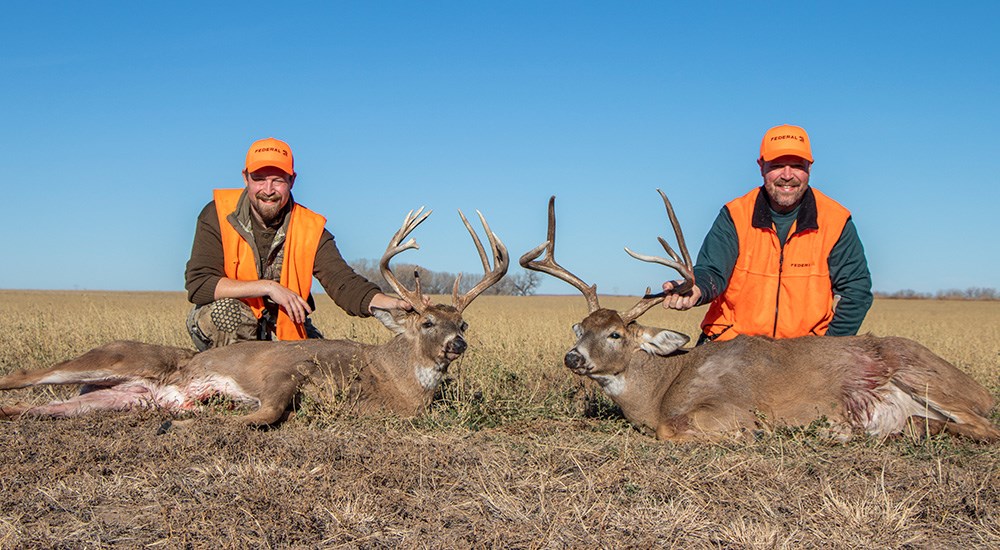 Ted has a 150-inch minimum goal in Kansas, like the author’s 153-inch buck, above left, but he’s got wiggle room for freaks, like the 142.7-inch 7-point taken by Federal’s JJ Reich, above right.
Ted has a 150-inch minimum goal in Kansas, like the author’s 153-inch buck, above left, but he’s got wiggle room for freaks, like the 142.7-inch 7-point taken by Federal’s JJ Reich, above right.
Jon: What are your thoughts on the best state for hunting whitetails? (I think I know the answer.)
Ted: I’ve hunted Florida, Iowa, Illinois and some other Midwestern states, but I’ve got to say Kansas, right?
Jon: I would think so.
Ted: What I think Kansas has going for it is agriculture. Deer are getting a lot of nutrition throughout the year. In the springtime they’re eating winter wheat, in the summer they’re eating alfalfa, and in the fall they’re eating alfalfa and all the supplemental feed that we hunters feed them, so food is never an issue. Unlike some Northern states that get a hard winter, we get no snow cover here, so these bucks, especially the post-rut bucks that are working hard just to survive, they’ve got plenty of nutrition. And we’ve got genetics. I think Kansas hunters, too—especially in areas with a lot of nonresident hunters—are getting pickier and pickier, letting the 3½ - 4½ year old bucks go. Those three ingredients—age, nutrition and genetics—are producing 200-inch deer in Kansas.
■ ■ ■
On Field Judging Trophy Bucks
Jon: When I was hunting with you in Kansas, you taught me your trick to field judging whitetails, and I found it to be not only incredibly accurate but incredibly simple, even for me, and that’s saying something. And while I love to imagine that we get along so well that you chose me alone to be worthy of this secret formula, it’s a method you share with all your clients. Well, I didn’t write it down the first time, and I don’t want to foul it up for my readers, so tell me again. What’s the Jaycox method for field judging big bucks?
Ted: Okay, so after years and years of measuring the mature Kansas bucks in this area, I came to notice some patterns. The frame of a mature buck’s rack—and when I say frame I mean everything except tine length, so we’re talking inside spread, length of both main beams and the four circumference measurements on each beam—equals out to somewhere between 90 and 95 inches when added together, and I use that as a base. So, when a mature buck comes in, he’s going to have between 90 and 95 inches of antler to start with, excluding tine length. I’ve got a 150-inch minimum guideline, so to be safe I tell my hunters to start with 90 inches, meaning they’ll need at least 60 inches of tines to reach 150 inches. If you can count 30 inches of tine length on one antler, on one side, and he’s fairly symmetrical, then he should easily make the 150-inch mark.
Jon: Yup, that’s it.
Ted: It’s a lot easier than trying to do a bunch of math in the field. You just don’t have time for much more than tines when a big buck walks in. Obviously, if a buck is super wide and he’s got a lot of mass, and maybe only 55 inches of tine length, but he’s got the extra mass, you can play that game. But to be safe, if you start with 90 inches as a base measurement and can add 60 inches of tine length, you’re in every time. It’s uncanny how close this method can get you, sometimes it’s within an inch, and it’s under 3 inches just about every time. Incidentally, this works for Coues deer, too.
Jon: Hold on, I’m trying to write this down.
Ted: Different numbers, though. For Coues you start with 70 inches instead of 90. One hundred inches is a minimum for us, so we’re looking for 15 inches of tine length on each side to make 100 inches.
Jon: Is the whitetail method universal? Will it work in Texas, or Pennsylvania?
Ted: I think it’ll work anywhere. You’d have to adjust for the frame measurement because I don’t know that a 4½-year-old deer in Pennsylvania or Texas will have a 90-inch frame, they may not have as much mass, but I think it would be close. If you were to measure a dozen or so heads from any area, you’d have a real good idea. And it all depends on what number you are trying to get at. In Florida, a 100-inch buck makes our big buck registry, so adjust accordingly.
■ ■ ■
On Tactics and Technique
Jon: Question about your personal hunting now. Are there any tools or equipment in your pack that you never hunt without? Something folks aren’t thinking of?
Ted: I’m a big fan of red and green lights for going in and out of stands. I don’t climb into a blind with a white light showing. It’s also nice to have a wind checker with you so you can move if the wind changes. Aside from that, I don’t know that I’ve got any big secrets, and if I did, I probably wouldn’t share them with you anyway.
Jon: I figured as much. What are your thoughts on scent control and playing the wind?
Ted: Wind is everything. I don’t think you can fool a whitetail’s nose. Scent elimination helps, and maybe gives you a little bit of an advantage, but I’ve got a saying: Nothing is better than anything. I’m not a fan of introducing other scents that deer aren’t familiar with. Apple scents, fox and skunk pee, all that stuff ... if a deer is walking through the woods and he’s not smelling anything, he’s going to keep walking. If he stops and smells something that he’s not used to, well, who knows? That’s not to say they don’t smell foxes and skunks on their own, but I don’t want to do anything that arouses the curiosity of the deer. Let him be a deer, and hope the wind is right so he doesn’t smell me, and then I can kill him.
Jon: What about rattling?
Ted: Well, it’s kind of the same thing with the scents: nothing is better than anything. I used to rattle a lot in Kansas when I first started hunting here, and at least 50 percent of the deer that I rattled to would turn and go the other way. It’s actually higher than that. If you’re in a thick area where you can’t see, like a river bottom, and you start rattling, you might have had a buck at 150 yards coming right down to your stand but now he’s going the other way. I have a few hunters that rattle every year, and not many of them are successful. I’m not a fan of rattling. Not a fan of scents. Not a fan of grunts. Put your stand in the right place, where there’s deer coming through already.
Jon: How about scrapes and mock scrapes?
Ted: I like hunting areas with scrapes. Shows you that deer are coming through. I don’t doctor up scrapes, because again, nothing is better than anything. Personally, I have peed in a scrape, and 15 minutes later a buck came by and just beat it up good; scraped and pissed right on top of mine. But I don’t recommend it.
Jon: It’s worked for me.
Ted: A red handkerchief works, too. If I put a red handkerchief around a group of bowhunters’ necks, and three of them come back with dead bucks, well, it’s because they had on a red handkerchief.
Jon: What are some of the common mistakes you’ve seen hunters make, other than declining your red handkerchief and covering themselves with fox urine?
Ted: They use their cell phones too much. They really do. Especially early morning when it’s still dark. They climb up into a box blind, turn their phones on to text their buddies and they light the place up like a Christmas tree. Then they’re preoccupied with it. I’ve had multiple hunters come in and sheepishly tell me that they couldn’t get their phone down and gun up in time to take advantage of an opportunity. I wish I was making that up. Probably not the answer you were expecting, but it’s legit. If you’ve done a good job going to your stand, you’ve probably got deer within a 150-yard-radius of you. So, being noisy going into your blinds and using cell phones. That’s my answer.
Jon: Okay, now for a personal question: What can I do to improve the quality of bucks on my property?
Ted: Get to know your neighbors. You’ve got to be on the same page on what a trophy deer is and your management plan. Be selective, understanding that if you pass up that 3½-year-old buck hoping he’ll become 4½, there’s a chance he might jump the fence and you never see him again, but if you kill him now, he’ll never make 4½. Also, food plots are the field of dreams. If you build it, they will come. I think water sources are important, too. If you hunt in an area where there is little water or deer are forced to travel far to get it, water makes a big difference.
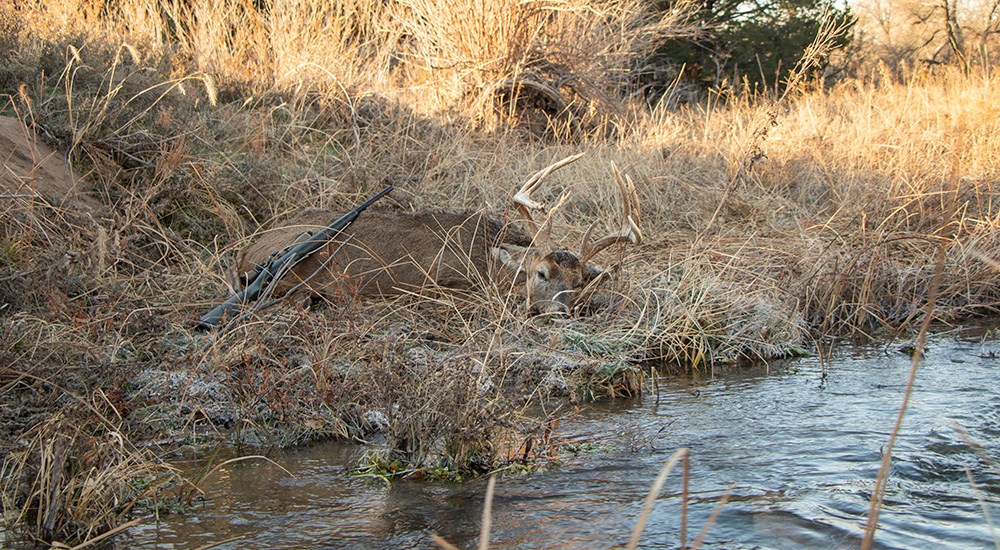
Jon: Is that as easy as putting out a water trough somewhere?
Ted: It can be just that easy. If you really want to do it right, find a low spot on the property where water tries to accumulate anyway and dig it out a little bit. Line it, and then put the dirt back on top of it. Deer love mud puddles. All animals like that mineral intake they get from muddy water.
Jon: Okay Ted, scenario time. You’ve got a hunter in the field who reports that he hit the deer but is not too sure of the shot. What’s the game plan?
Ted: Give him time. Know where the buck was standing and what direction he went, and don’t go anywhere near that area. Go back to your truck, go back to camp, and give him several hours. Then cautiously go back in to point-of-last-contact and see if you can pick up blood or sign. We don’t lose very many deer in Kansas because we give them time. If I don’t see him go down, then I’m going to give him lots of time.
Jon: Okay, opposite scenario. An incredibly capable, yet nameless hunter claims he made an awesome shot, and heck, maybe he’s looking at a dead deer. He calls you and say’s “Big buck down.” And despite said hunter’s assurance that the buck is dead, when you finally get up to him, the damn buck jumps up and takes off like my brother when the bar bill shows up, leaving your startled and dumbfounded hunter to stare at you with sad, desperate eyes. What do you do in this purely hypothetical situation?
Ted: Well, as you may recall, I quiz my reluctant hunter about his shot again. How did the deer react? Did he kick? Did he run off with a leg flopping? Was he limping? Spilling blood?
Jon: He was dead, Ted! Well, obviously not, but damnit, he acted stone dead, until he hauled ass like he was startled from a nap! There was a decent amount of blood where he once was, my only proof of a hit, but no real trail after that, if you recall. You made the decision to back out for the night pretty quickly.
Ted: Give him time.
Jon: And I believe you said it on the drive home, that we would go back out in the morning to the river not far from there and start looking. I’m still amazed at how we pulled that one off. How did you know that deer would likely go to water?
Ted: Experience, really, has taught me over the years that wounded deer get sick and feverish—especially when you’ve got a less than ideal shot. I’ve found so many deer laying dead in the water that it leads me to believe that they’re fevered up and thirsty and trying to cool down. Especially if he’s gut-shot. If he’s gut-shot, water is where he’ll be—if you didn’t push him out of the county or the coyotes didn’t run him, that is. You’ve got to start somewhere, and that’s the most obvious to me. I’ve recovered deer that were so hot to the touch that you couldn’t lean your body against them. I mean burning up with heat.
Jon: Well, it worked. Even though my buck wasn’t gut-shot.
Ted: If you say so.
Jon: It was the dreaded no-man’s-land, I tell you. Could of happened to anyone, but let’s move on. Okay Ted, final question. This issue will be hitting mailboxes in late November. Give my readers a tip. What’s the end of November through December game plan?
Ted: Well, I’d say they are still rutting some at the end of November here in Kansas, but that’ll be dropping off. When it does, they’ll be looking for food. I’d concentrate on food sources. Watch your wind, watch your noise going in and out, and put your phones down and you’ll have a good chance at a mature buck.
Interested in hunting trophy Kansas whitetails? How about a south-of-the-border hunt for the “Grey Ghost” Coues deer? Or maybe you’re trying to finish off your world slam with a Gould’s or Ocellated turkey? Ted Jaycox’s Tall Tine Outfitters won’t disappoint.
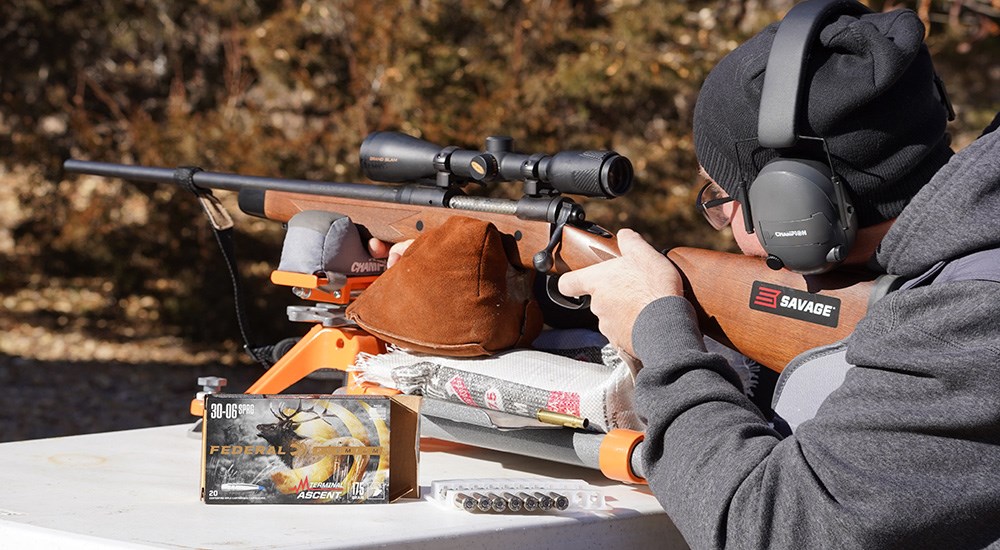
A Good Hunting Bullet: Federal Premium Terminal Ascent
The only real connection you have to any whitetail deer you’re hunting is the bullet, or at least that’s the goal. Assuming you can put it in the right place, you need to have confidence that said bullet will do what you want it to do: kill. More than just poking holes, a good hunting bullet should be able to hold together through hide and bone, expand and penetrate deep, release devastating energy and, of course, it’d be great if it could do all of that at varying velocities and ranges, from muzzle-fast to extended-range slow. Here’s a bit more knowledge, and I say this with confidence born from both personal experience and the experience of hunters better than I: Federal Premium Terminal Ascent checks all the boxes. Learn more at federalpremium.com.




































